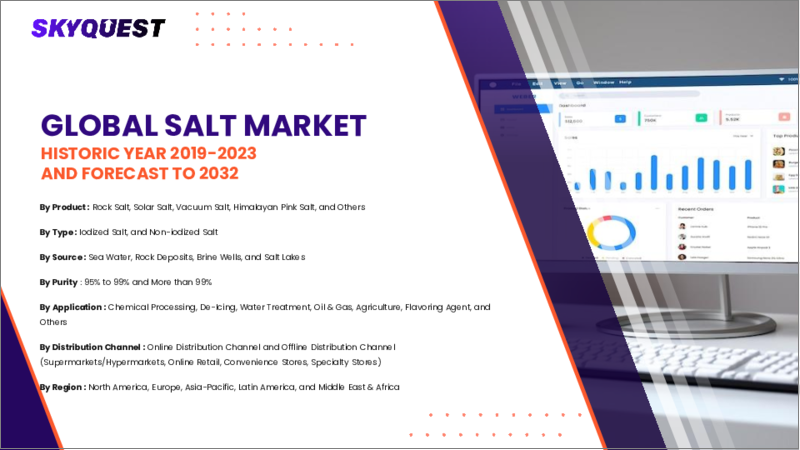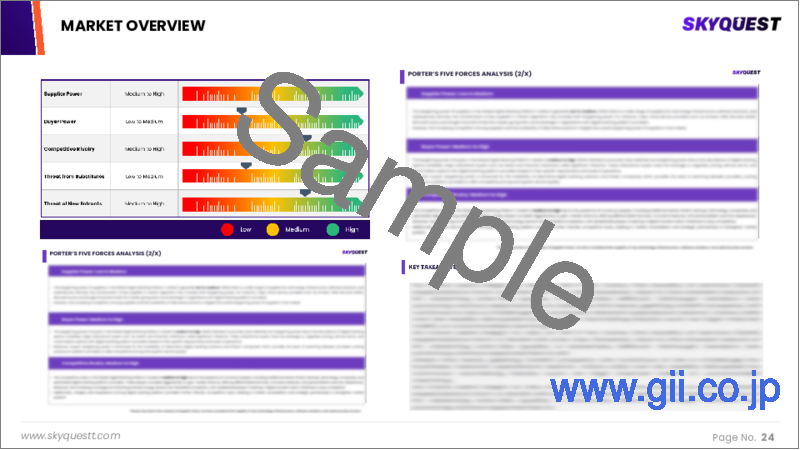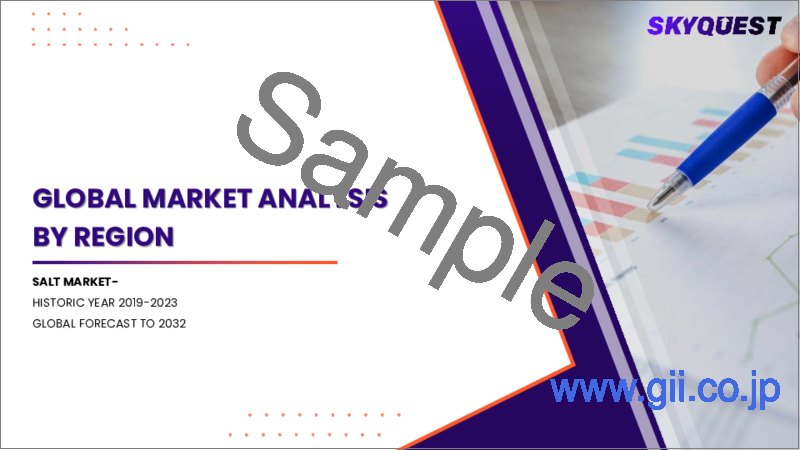|
|
市場調査レポート
商品コード
1646342
塩の市場規模、シェア、成長分析:タイプ別、供給源別、用途別、地域別 - 産業予測 2025~2032年Salt Market Size, Share, Growth Analysis, By Type (Rock Salt, Salt in Brine), By Source (Brine, Salt Mines), By Application, By Region - Industry Forecast 2025-2032 |
||||||
|
|||||||
| 塩の市場規模、シェア、成長分析:タイプ別、供給源別、用途別、地域別 - 産業予測 2025~2032年 |
|
出版日: 2025年01月25日
発行: SkyQuest
ページ情報: 英文 165 Pages
納期: 3~5営業日
|
全表示
- 概要
- 目次
塩市場規模は2023年に360億米ドルと評価され、2024年の379億8,000万米ドルから2032年には582億9,000万米ドルに成長し、予測期間(2025~2032年)のCAGRは5.5%で成長する見通しです。
塩は世界中で消費されている必須ミネラルであり、タフツ大学の研究者は、全世界の成人1人当たりの1日平均摂取量を3.95gと推定しています。世界で最も貴重なミネラルのひとつである塩は、人間の栄養学において重要な役割を果たしており、化学処理、食品製造、水処理など、さまざまな分野で多様な用途があります。化学製造プロセスにおける塩の需要の高まりは、今後数年間の市場成長を促進すると予想されます。この動向は、塩が食生活の主食としてだけでなく、様々な産業用途の主要成分としても重要であることを浮き彫りにしており、進化し続ける世界市場情勢の中で貴重な資産として位置づけられています。
目次
イントロダクション
- 調査の目的
- 調査範囲
- 定義
調査手法
- 情報調達
- 二次データと一次データの方法
- 市場規模予測
- 市場の前提条件と制限
エグゼクティブサマリー
- 世界市場の見通し
- 供給と需要の動向分析
- セグメント別機会分析
市場力学と見通し
- 市場概要
- 市場規模
- 市場力学
- 促進要因と機会
- 抑制要因と課題
- ポーターの分析
主な市場の考察
- 重要成功要因
- 競合の程度
- 主な投資機会
- 市場エコシステム
- 市場の魅力指数(2024年)
- PESTEL分析
- マクロ経済指標
- バリューチェーン分析
- 価格分析
- ケーススタディ分析
- 顧客と購買基準の分析
塩市場規模:タイプ別
- 市場概要
- 岩塩
- 塩水塩
- 天日塩
- 真空釜製塩
塩市場規模:供給源別
- 市場概要
- 塩水
- 塩鉱山
塩市場規模:用途別
- 市場概要
- 化学処理
- 除氷
- 水治療
- 石油・ガス
- 農業
- 香料
- その他
塩市場規模
- 北米
- 米国
- カナダ
- 欧州
- ドイツ
- スペイン
- フランス
- 英国
- イタリア
- その他欧州地域
- アジア太平洋地域
- 中国
- インド
- 日本
- 韓国
- その他アジア太平洋地域
- ラテンアメリカ
- ブラジル
- その他ラテンアメリカ地域
- 中東・アフリカ
- GCC諸国
- 南アフリカ
- その他中東・アフリカ
競合情報
- 上位5社の比較
- 主要企業の市場ポジショニング(2024年)
- 主な市場企業が採用した戦略
- 市場の最近の動向
- 企業の市場シェア分析(2024年)
- 主要企業の企業プロファイル
- 会社概要
- 製品ポートフォリオ分析
- セグメント別シェア分析
- 収益の前年比比較(2022~2024年)
主要企業プロファイル
- Cargill(United States)
- K+S AG(Germany)
- Tata Chemicals Limited(India)
- China National Salt Industry Corporation(CNSIC)(China)
- Compass Minerals International, Inc.(United States)
- AkzoNobel N.V.(Netherlands)
- Dampier Salt Limited(a subsidiary of Rio Tinto Group)(Australia)
- Lion Salt Works Trust(United Kingdom)
- Wacker Chemie AG(Germany)
- Zoutman Industries NV(Belgium)
- Dominion Salt Limited(New Zealand)
- Salins Group(France)
- Sudwestdeutsche Salzwerke AG(Germany)
- United Salt Corporation(United States)
- Eurosalt(Italy)
- Cerebos Limited(a subsidiary of Suntory Beverage & Food Limited)(Australia)
結論と推奨事項
Salt Market size was valued at USD 36.0 billion in 2023 and is poised to grow from USD 37.98 billion in 2024 to USD 58.29 billion by 2032, growing at a CAGR of 5.5% during the forecast period (2025-2032).
Salt is an essential mineral consumed universally, with Tufts University researchers estimating an average daily intake of 3.95 grams per adult globally. As one of the world's most valuable minerals, salt plays a crucial role in human nutrition and has diverse applications across various sectors, including chemical processing, food production, and water treatment. The escalating demand for salt in chemical manufacturing processes is anticipated to drive market growth in the forthcoming years. This trend highlights salt's significance not only as a dietary staple but also as a key ingredient in a range of industrial applications, positioning it as a valuable asset in the ever-evolving global market landscape.
Top-down and bottom-up approaches were used to estimate and validate the size of the Salt market and to estimate the size of various other dependent submarkets. The research methodology used to estimate the market size includes the following details: The key players in the market were identified through secondary research, and their market shares in the respective regions were determined through primary and secondary research. This entire procedure includes the study of the annual and financial reports of the top market players and extensive interviews for key insights from industry leaders such as CEOs, VPs, directors, and marketing executives. All percentage shares split, and breakdowns were determined using secondary sources and verified through Primary sources. All possible parameters that affect the markets covered in this research study have been accounted for, viewed in extensive detail, verified through primary research, and analyzed to get the final quantitative and qualitative data.
Salt Market Segments Analysis
Global Salt Market is segmented by Type, Source, Application and region. Based on Type, the market is segmented into Rock Salt, Salt in Brine, Solar Salt and Vacuum Pan Salt. Based on Source, the market is segmented into Brine and Salt Mines. Based on Application, the market is segmented into Chemical Processing, De-icing, Water Treatment, Oil & Gas, Agriculture, Flavoring Agent and Others. Based on region, the market is segmented into North America, Europe, Asia Pacific, Latin America and Middle East & Africa.
Driver of the Salt Market
The salt market is significantly driven by the rising demand for salt in the chemical manufacturing sector, especially for producing chlorine-alkali compounds. This sector heavily relies on salt due to the lack of cost-effective alternatives, making chlorine-alkali one of the primary consumers of salt. As industries continue to seek reliable sources of chlorine-alkali compounds for various applications, the requirement for salt is expected to grow, further propelling the market. Consequently, the consistent demand from the chemical sector plays a crucial role in shaping the dynamics of the salt market, highlighting its importance in industrial processes.
Restraints in the Salt Market
The salt market faces several constraints primarily due to the need for obtaining additional permits and licenses from mining authorities globally, which complicates the extraction process and aims to limit production. Furthermore, the fluctuating operational capacities of mining facilities, which can be significantly affected during periods of increased demand for de-icing products, contribute to a slowdown in market growth throughout the forecast period. These regulatory hurdles and the inconsistent production capacity due to variable demand can create challenges for industry players, ultimately hindering the overall expansion of the salt market in the coming years.
Market Trends of the Salt Market
The salt market is experiencing a notable trend towards seasoned and flavored salts, driven by consumers' desire to explore diverse culinary experiences. As flavor profiles deepen, flavored salts are surpassing traditional seasoning mixes in popularity. This surge is particularly pronounced in emerging markets where westernization fosters an affinity for international cuisines, such as Italian and French fare, thereby increasing the demand for unique salt variations. The rise of e-commerce platforms, like Amazon and specialized retailers, has made accessing these products easier, especially among younger consumers drawn to bold flavors. Additionally, restaurants are capitalizing on this trend by incorporating flavored salts like jalapeno into their dishes, catering to the growing palate for spicy foods.
Table of Contents
Introduction
- Objectives of the Study
- Scope of the Report
- Definitions
Research Methodology
- Information Procurement
- Secondary & Primary Data Methods
- Market Size Estimation
- Market Assumptions & Limitations
Executive Summary
- Global Market Outlook
- Supply & Demand Trend Analysis
- Segmental Opportunity Analysis
Market Dynamics & Outlook
- Market Overview
- Market Size
- Market Dynamics
- Drivers & Opportunities
- Restraints & Challenges
- Porters Analysis
- Competitive rivalry
- Threat of substitute
- Bargaining power of buyers
- Threat of new entrants
- Bargaining power of suppliers
Key Market Insights
- Key Success Factors
- Degree of Competition
- Top Investment Pockets
- Market Ecosystem
- Market Attractiveness Index, 2024
- PESTEL Analysis
- Macro-Economic Indicators
- Value Chain Analysis
- Pricing Analysis
- Case Study Analysis
- Customer And Buying Criteria Analysis
Global Salt Market Size by Type & CAGR (2025-2032)
- Market Overview
- Rock Salt
- Salt in Brine
- Solar Salt
- Vacuum Pan Salt
Global Salt Market Size by Source & CAGR (2025-2032)
- Market Overview
- Brine
- Salt Mines
Global Salt Market Size by Application & CAGR (2025-2032)
- Market Overview
- Chemical Processing
- De-icing
- Water Treatment
- Oil & Gas
- Agriculture
- Flavoring Agent
- Others
Global Salt Market Size & CAGR (2025-2032)
- North America (Type, Source, Application)
- US
- Canada
- Europe (Type, Source, Application)
- Germany
- Spain
- France
- UK
- Italy
- Rest of Europe
- Asia Pacific (Type, Source, Application)
- China
- India
- Japan
- South Korea
- Rest of Asia-Pacific
- Latin America (Type, Source, Application)
- Brazil
- Rest of Latin America
- Middle East & Africa (Type, Source, Application)
- GCC Countries
- South Africa
- Rest of Middle East & Africa
Competitive Intelligence
- Top 5 Player Comparison
- Market Positioning of Key Players, 2024
- Strategies Adopted by Key Market Players
- Recent Developments in the Market
- Company Market Share Analysis, 2024
- Company Profiles of All Key Players
- Company Details
- Product Portfolio Analysis
- Company's Segmental Share Analysis
- Revenue Y-O-Y Comparison (2022-2024)
Key Company Profiles
- Cargill (United States)
- Company Overview
- Business Segment Overview
- Financial Updates
- Key Developments
- K+S AG (Germany)
- Company Overview
- Business Segment Overview
- Financial Updates
- Key Developments
- Tata Chemicals Limited (India)
- Company Overview
- Business Segment Overview
- Financial Updates
- Key Developments
- China National Salt Industry Corporation (CNSIC) (China)
- Company Overview
- Business Segment Overview
- Financial Updates
- Key Developments
- Compass Minerals International, Inc. (United States)
- Company Overview
- Business Segment Overview
- Financial Updates
- Key Developments
- AkzoNobel N.V. (Netherlands)
- Company Overview
- Business Segment Overview
- Financial Updates
- Key Developments
- Dampier Salt Limited (a subsidiary of Rio Tinto Group) (Australia)
- Company Overview
- Business Segment Overview
- Financial Updates
- Key Developments
- Lion Salt Works Trust (United Kingdom)
- Company Overview
- Business Segment Overview
- Financial Updates
- Key Developments
- Wacker Chemie AG (Germany)
- Company Overview
- Business Segment Overview
- Financial Updates
- Key Developments
- Zoutman Industries NV (Belgium)
- Company Overview
- Business Segment Overview
- Financial Updates
- Key Developments
- Dominion Salt Limited (New Zealand)
- Company Overview
- Business Segment Overview
- Financial Updates
- Key Developments
- Salins Group (France)
- Company Overview
- Business Segment Overview
- Financial Updates
- Key Developments
- Sudwestdeutsche Salzwerke AG (Germany)
- Company Overview
- Business Segment Overview
- Financial Updates
- Key Developments
- United Salt Corporation (United States)
- Company Overview
- Business Segment Overview
- Financial Updates
- Key Developments
- Eurosalt (Italy)
- Company Overview
- Business Segment Overview
- Financial Updates
- Key Developments
- Cerebos Limited (a subsidiary of Suntory Beverage & Food Limited) (Australia)
- Company Overview
- Business Segment Overview
- Financial Updates
- Key Developments





